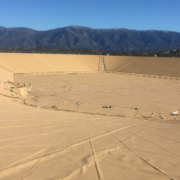The Valley Center Municipal Water District has been advised by the California State Water Resources Control Board that its Cool Valley Reservoir Cover Replacement Project was recognized by the Environmental Protection Agency’s new AQUARIUS Program as an “Exceptional Project,” among only 10 identified as such nationwide.
Each year, EPA’s Aquarius Program recognizes one Drinking Water State Revolving Fund project from each of its 10 regions nationwide for “exceptional focus on sustainability, protection of public health” while demonstrating a high level of innovation.
The $4.2 million Cool Valley Reservoir Cover Project was nominated by the SWRCB, EPA’s state-level partner in the DWSRF Program in California.
Cool Valley Reservoir Project ‘Innovative’
Constructed in 1975 and with the original floating flexible reinforced “Hypalon” material installed in 1992, Cool Valley is Valley Center’s largest drinking water reservoir with a capacity of 57 million gallons, providing about 40% of the District’s total covered drinking water storage capacity. By 2015, the floating cover had reached its full life expectancy and started to experience failures, possibly placing the quality of the water in the reservoir at risk.
At that point the decision was made to take the reservoir out
of service and seek DWSRF financing to cover the estimated $4.2 million project
cost, rather than make additional repairs to the existing liner.
With interim adjustments to system operations and cooperation from Valley Center’s wholesale supplier, the San Diego County Water Authority, the system operated reliably with Cool Valley off-line.
‘Exceptional Project’ reduces bacteria and energy use
District engineering staff and consultants were successful in securing the 20-year loan at 1.6% interest. With the loan secured, the project was approved by the Valley Center Board in the FY 2015/2016 Budget. The project took 12 months to complete and was back on line by mid-2017. The effort was overseen by Wally Grabbe, District Engineer and managed by Dennis Williams (retired), Deputy District Engineer.
Projects nominated by the states must meet three major
criteria, including providing Safe Drinking Water Compliance, Public Health
Benefit and having Financial Integrity.
Additionally, each project must demonstrate leadership in dealing with
emerging contaminants, aging infrastructure or innovative financing,
affordability, water loss control, efficient water and/or energy use, creative
approach to project planning and implementation, and/or creating water system
partnerships.
In making the award, the SWRCB and EPA noted that the Valley Center Cool Valley Project will not only protect water quality from atmospheric vectors, but the new cover-liner will “prevent leakage from the reservoir, reduce bacteria by creating a barrier between the drinking water and the concrete liner… and reduce chemical and energy use.
During the same period of time, the Valley District designed and installed a 95kW Photovoltaic Solar Array and upgraded the Cool Valley Pump Station, all located on the Cool Valley Reservoir site.



